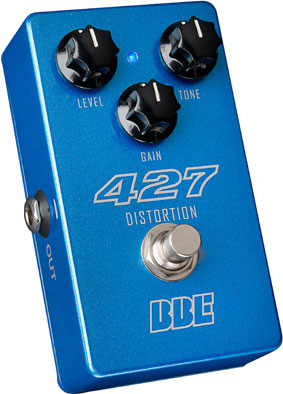
427™ FD-427P
The all-analog 427 is the modern muscle car of distortion pedals, with a big, meaty tone that’s ready to kick ass. Another Paul Gagon creation, 427 builds on his experience crafting pedals for the gods of rock, but this one’s got a distinctly American voice.
427 fires up with a potent variation of Gagon’s proven LED-based distortion circuit as used in the BBE Blacksmith, with the power flowing to a sweepable EQ (CSEQ) section inspired by an early ’70s Big Muff Pi and optimized for maximum flexibility.
On a mission to raise hell on rock ‘n roll streets from New York to L.A., 427 delivers more raw power than yesteryear’s muscle with better handling. With a beefy mil-spec circuit board sporting big, fat signal traces, 1% metal-film resistors and high-voltage poly caps, 427 is engineered to be deliver rock-solid performance and never leave you stranded. And when you aren’t in the mood to lay down serious rubber, 427’s true hardwire bypass lets your tone slip by without so much as angry glance from the tone police.
BBE 427: Modern Muscle.
Tech Focus: LED distortion circuit
When many people think of LEDs, they think of flashlights. So what is an LED doing in a distortion circuit? Well, it’s not there to illuminate the inside of the pedal. Before we get into LEDs, let’s take a look at the basics of a distortion circuit. Since the late ‘60s many distortion circuits have used a diode to create the distortion. As the signal passes through the diode, it will turn a sine-wave into a square-wave, “clipping” the top and bottom of the sine-wave, resulting in a massive amount of even and odd order harmonics generated. That’s the distortion sound.
An LED is a Light Emitting Diode, but in a distortion circuit it won’t actually emit light because the current passing through it is far too low. In this case, the LED is used to accomplish the same function as a silicon “small signal diode” which is a basic rectifying device. The primary benefit of an LED is that it has a greater voltage swing, about +/- 1.4 volts versus a silicon diode which has a voltage swing of about a +/ 0.7 volts. That means an LED is capable of a higher output level, driving the input of an amp harder and making the tubes clip (distort) more. There’s more to it, though. An LED can provide a smoother transition in-to and out-of the clipped ends of the wave-form, creating less of the very high harmonics that might be described as “shrill.” While post-EQ can manage those harmonics as we do in the BBE Green Screamer, and the LED-based distortion circuit in the Blacksmith offers smoother distortion.
So how where did this idea of using an LED for distortion come from? Turns out that Paul Gagon came up with the LED idea around the same time as his friends at Tom Sholz’ Rockman. In a conversation with one of the Rockman engineers, Paul explained how he figured out that the properties of an LED would be practical for a distortion circuit, and in fact some of the Jackson artists had raved about pedals he’d made for them. Keep in mind that many artists were using both Jackson guitars and Rockmans for practice. The Rockman guys told Paul they’d found the very same solution with LEDs, and had started making their own LED-based distortion circuits. We think it’s this is a great example of how great engineers often come to the same conclusions, and in this case, between Gagon’s pedals and the Rockman products, so much of the most memorable, searing metal tones of the ‘80s were created.
Features include
- Gain, level and continuously-sweepable EQ tone control
- LED-based gain circuit for smooth, high-output distortion
- 1MEG Ohms input impedance for proper pickup loading
- 10K Ohms output impedance when engaged
- 1% metal-film resistors for consistency
- High-voltage poly caps for better tone
- Military-spec circuit board for reliability
- Blue status LED for high visibility and low power consumption
- Easy access battery compartment
- True hardwire bypass
- 5-year warranty
Designed and Engineered in USA
Made in China
Guitar World's Paul Riaro demos the 427